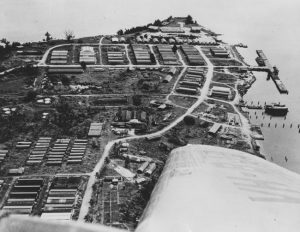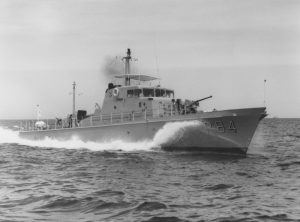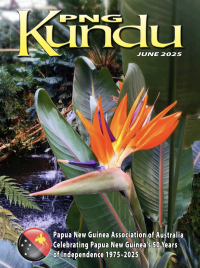Lombrum: Jerry Lattin
From 1963 to 1965 I was in command of the small naval cargo ship HMAS Banks in PNG waters. Later, in 1970, I had a year in HMAS Aitape commanding the PNG Patrol Boat Squadron. Our home port in both cases was the RAN base at Lombrum on Los Negros Island in the Manus District. Los Negros is separated from Manus Island by the narrow Loniu Passage, and connected to it by a road bridge. The airport, Momote, is also on Los Negros; district headquarters, Lorengau, is on Manus.
In keeping with naval custom, the Lombrum base carried a ship’s name, HMAS Tarangau – a particularly well-chosen one given that the great harbour it fronted had been named Seeadler Hafen (harbour) by the Germans after the ship that discovered it for the first colonists. ‘Seeadler’ is sea-eagle in German; ‘tarangau’ is its pidgin equivalent.
The Manus district had a population of around 60,000. The three main tribal groups were the north-coast people who also occupied the fringing northern islands; the bush people of the interior, known as the Usiai; and the ‘Manus’ (meaning ‘true’) people of the south coast and off-lying islands. The latter, a people of impressive spirit and social cohesion, were the subject of intensive research by the American anthropologist Margaret Mead from the 1930s onward.
A prominent and very colourful Manus identity was their first MEMBER OF THE House of Assembly, Paliau Maloat MBE. Originally from the island of Baluan off the south coast, Paliau had had a difference of opinion with the Catholic Church and dealt with the contretemps by leaving Catholicism behind and forming his own Christian church with himself as head. He had considerable powers of persuasion and leadership, was not averse to stirring up trouble and could adapt quickly to changing circumstances. There was allegedly an incident in the 1950s when a single Australian schoolteacher on one of the isolated southern islands – Paliau country – had his house destroyed by arson. The navy was asked to help convey police to the scene of the crime. Stepping ashore with rifles, the police were met by assembled schoolchildren, singing ‘God Save the Queen’ and casting flowers over them. Paliau readily admitted burning down the teacher’s house. ‘It was a terrible house’, he said. ‘We’re going to build him a much better one’.

An overflight of Tarangau showing the wharf area and rows of WWII era Quonset huts that were used variously as workshops, storage facilities and for accommodation.
Manus had been a massive American naval base during World War II, but the tides of war quickly passed it by and it was abandoned after 1945. Australian forces returned to Los Negros in the early 1950s. The naval fuelling facilities were important for ships transiting to and from the Korean war zone, and the RAAF refurbished the strip at Momote – still one of the finest in PNG. But with the cessation of the Korean conflict, the need for such presence began to dwindle. The RAAF withdrew and the naval presence was reduced to little more than a skeleton crew. When I first arrived at Tarangau in 1963, the Australian component of the base was down to seven officers and about 80 NCOs and sailors. Additional uniformed strength came from about 120 locally-engaged men in the PNG Division of the navy, supplemented by a civilian labour line of perhaps 300.
A popular humorous novel published about then was Don’t Go Near the Water by William Brinkley, a story of an American naval base on a remote Pacific Island where they had nothing to do and where nothing ever happened. (Later it became a successful film with Glenn Ford and Gia Scala.) At Tarangau in the sixties, I felt we were reliving the story. I recall the general horror that greeted the suggestion by some dangerously-progressive officer that the base would be more efficient if we installed a telephone system. ‘What do we need telephones for?’ said the Commander, outraged; ‘I don’t want to be bothered by telephones ringing all the time. If I need to talk to anyone I can do it face to face.’ He could too; anybody more than five minutes away was probably lost in the surrounding jungle.
Lombrum in the 1960s was a capital-B Backwater. Social life consisted of seeing the same faces in different houses. Lombrumites even had the same entertainment: at parties, invariably, they played charades; in the mess, every night, it was liar’s dice or pontoon. Once a week there was a movie; the Sydney Sunday papers came on Tuesday or Wednesday. The big excitement was the six-weekly visit by the Burns Philp liner MV Malaita, with stores and fresh food. It really wasn’t tedious and humdrum; it was more comforting routine. Readers familiar with outstation life know what it’s like; to some of them, Lombrum would be like Gay Paree. And for me, Lombrum was just home base; most of the time I was sea-borne, and elsewhere.
But there was no stopping progress. When I came back to Tarangau for my second spell in 1970 (accompanied at first by a wife, and later by a daughter as well – a native-born Los Negrossian), telephones were everywhere, even in the houses! Tarangau was booming. The new patrol boat squadron gave the establishment purpose and focus. The base had also rediscovered its strategic significance as a fuelling and logistic base for naval units transiting to and from Vietnam operations. The navy put considerable effort into recruiting appropriately-qualified locals for the patrol boats and their shore support facilities. Some went to Australia for training. The five patrol boats, in the PNG context, were not seen as weapons of war, but rather as the means of exercising sovereignty over PNG’s exclusive economic zone and its fishing and mineral resources. Self-government and eventual independence were on the agenda.
My final year at Tarangau was shore-based, as Executive Officer (second-in-command) of the base. When I left at the end of 1971, Tarangau had the PNG flag flying in company with the Australian one. Just before I left Tarangau, I paid a Christmas visit to Paliau at Mbunai village on the south coast of Manus. Mbunai residents came home for Christmas from all over PNG. Several days were devoted to eating, worshipping, and playing sport. Church services went on practically around the clock, with Paliau leading all of them in a blue-and-white calico outfit, cape and all, vaguely reminiscent of Superman’s uniform.
I was set to leave on Boxing Day morning, but Paliau insisted that I stay to attend ‘the gathering’ that afternoon, which turned out to be a sort of political meeting, with all the speeches coming from Paliau. After one long harangue on the importance of education, self-improvement and development of village facilities, he sat down and said to me ‘Now you can talk to them.’ I was unprepared for this. ‘What do you want me to say?’ I asked. ‘Tell them about the navy’, he said, ‘You must tell them the navy will never leave Manus.’ I was between a rock and a hard place. If I declined, I was effectively saying that the navy would be leaving one day. On the other hand, if I complied, my words could come back to haunt me. Even then, I doubted that the navy had any position on how long it would remain in Manus; defence planning adapts to changing needs, and changes often to reflect circumstances. And in a very short time it would be a PNG decision, not an Australian one anyway. But I thought, what the hell, there are no media here, my boss won’t hear about it, and I’ll be gone in a few days. So I told them what Paliau wanted to hear. No doubt he took the credit. More than 35 years later, I’m relieved to say, the RAN’s successor at Lombrum, the PNG Defence Force (Maritime), is still there. A self-fulfilling prophecy, perhaps?




